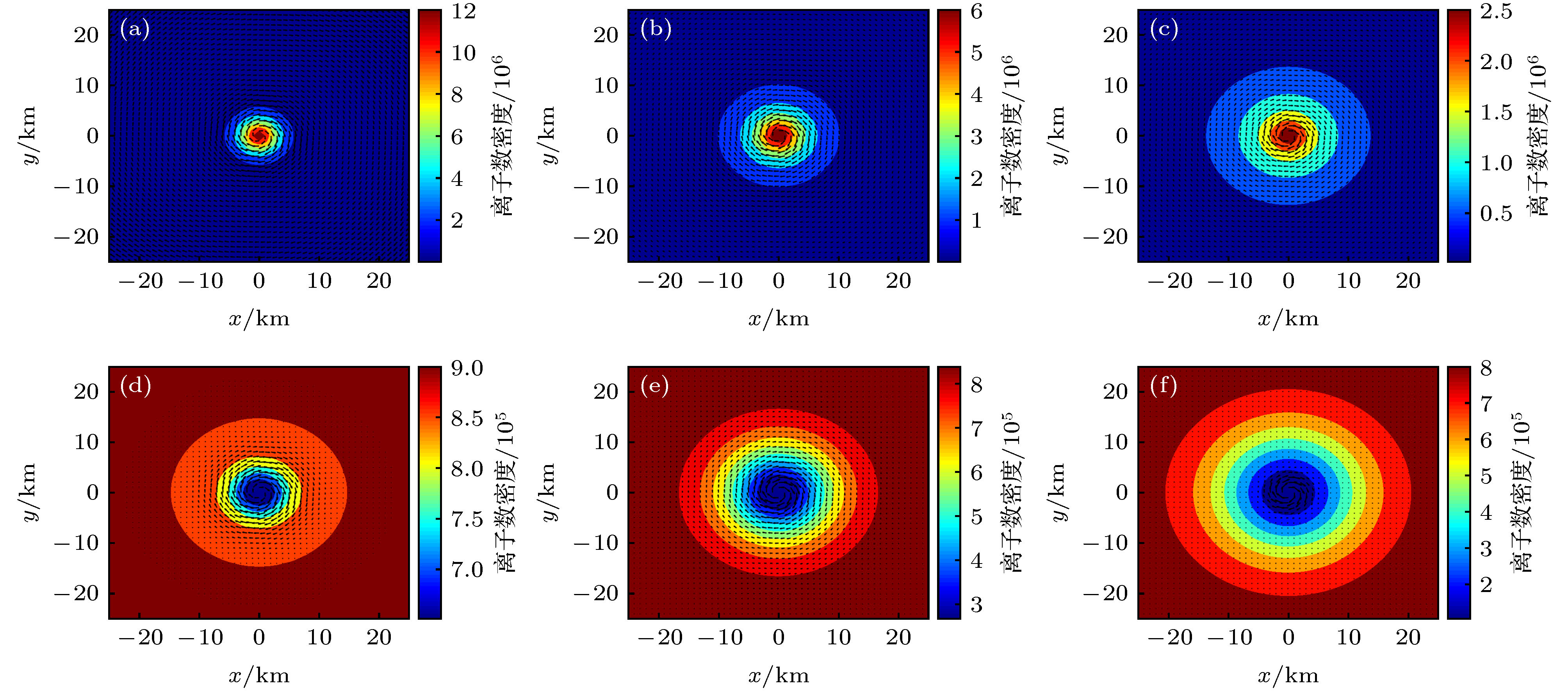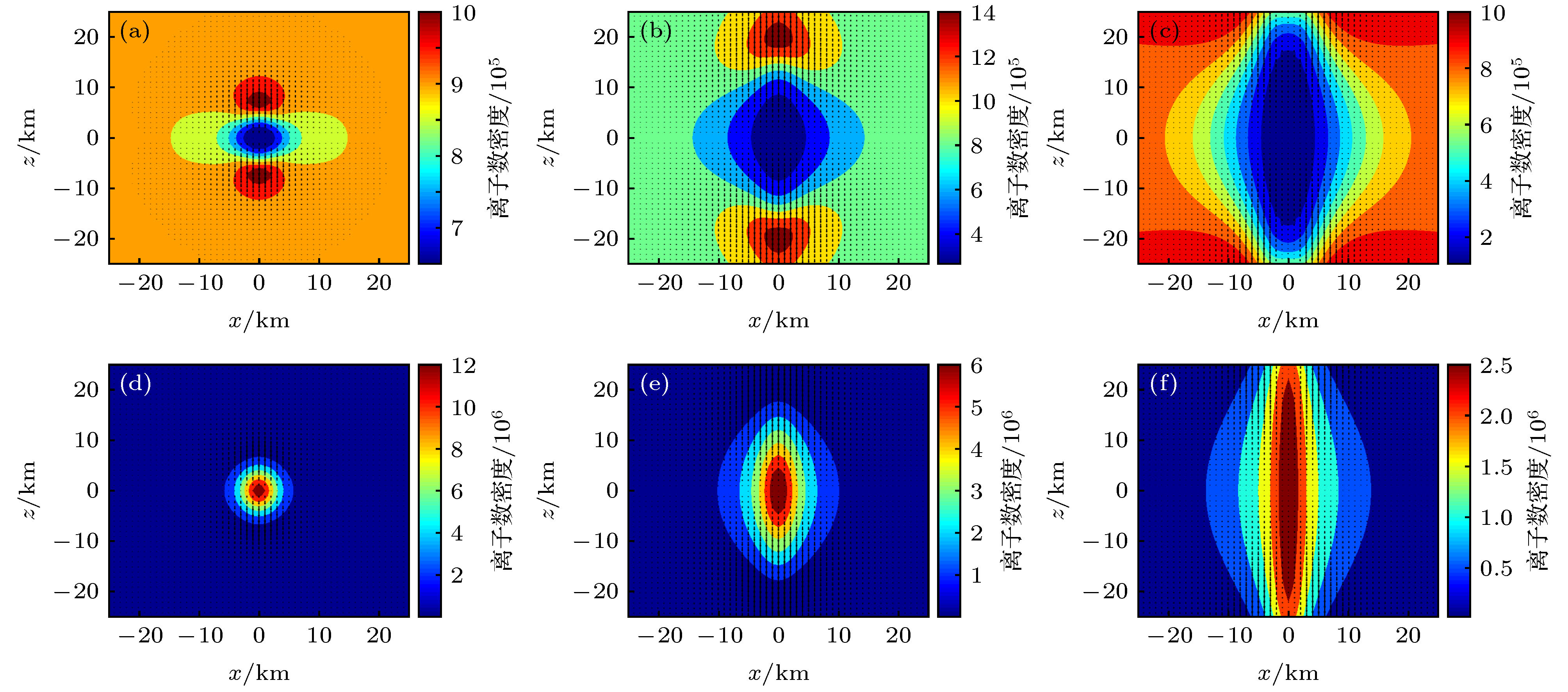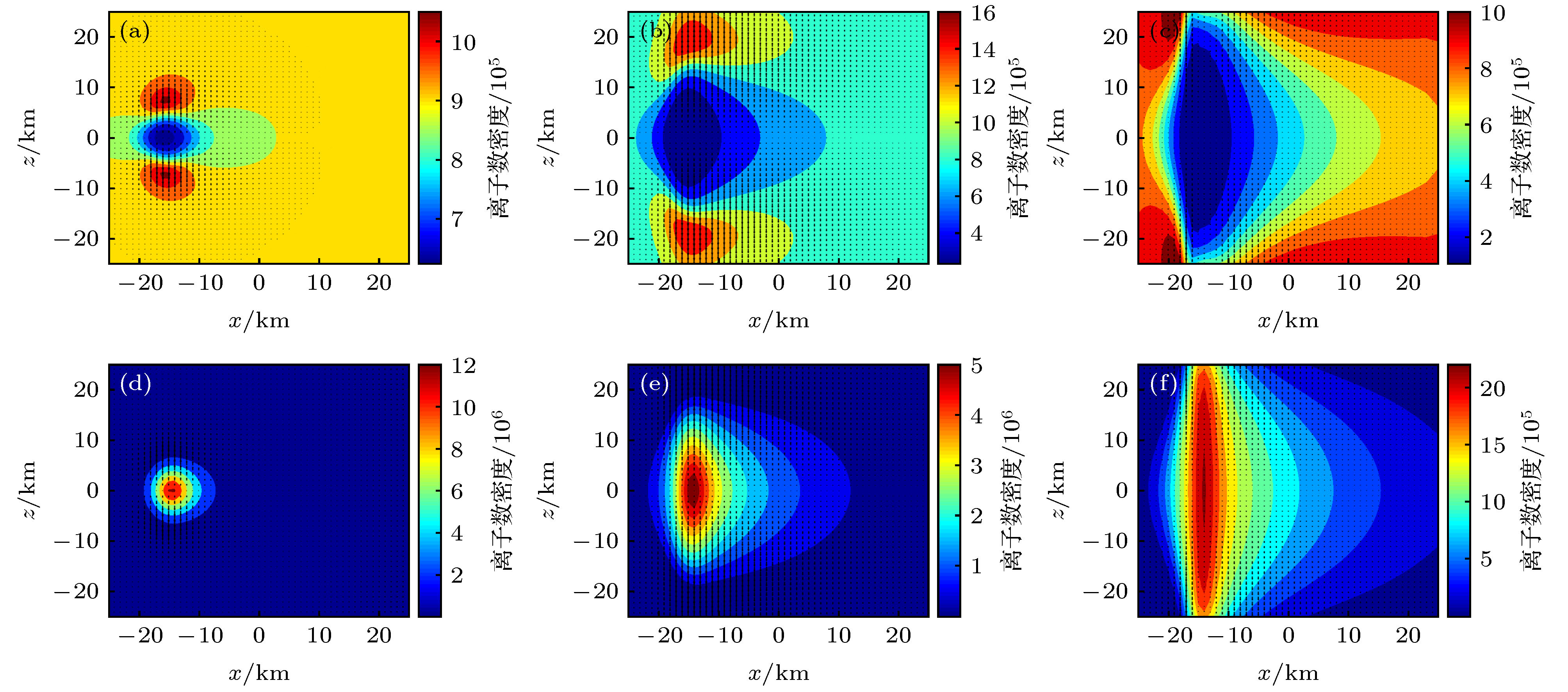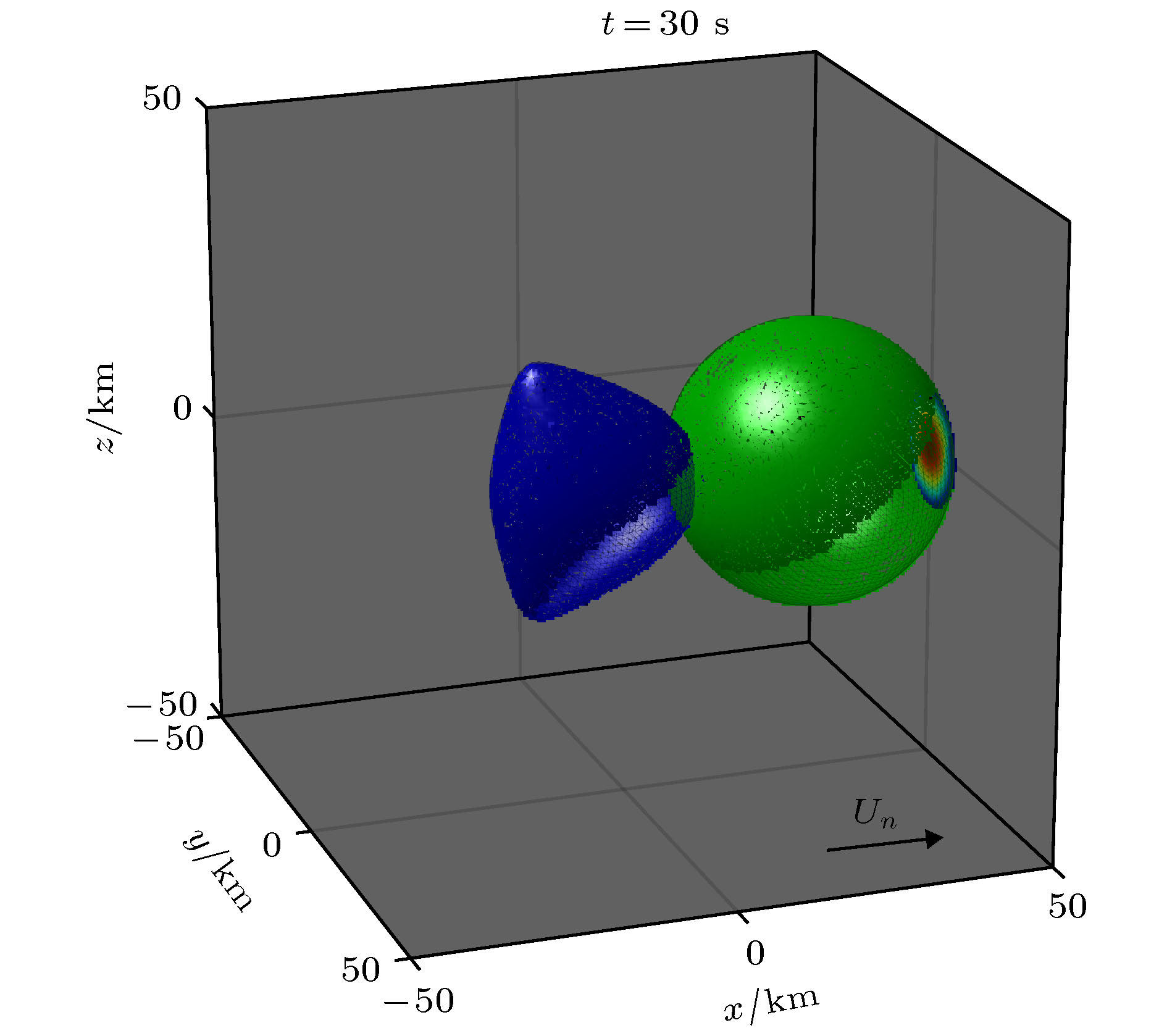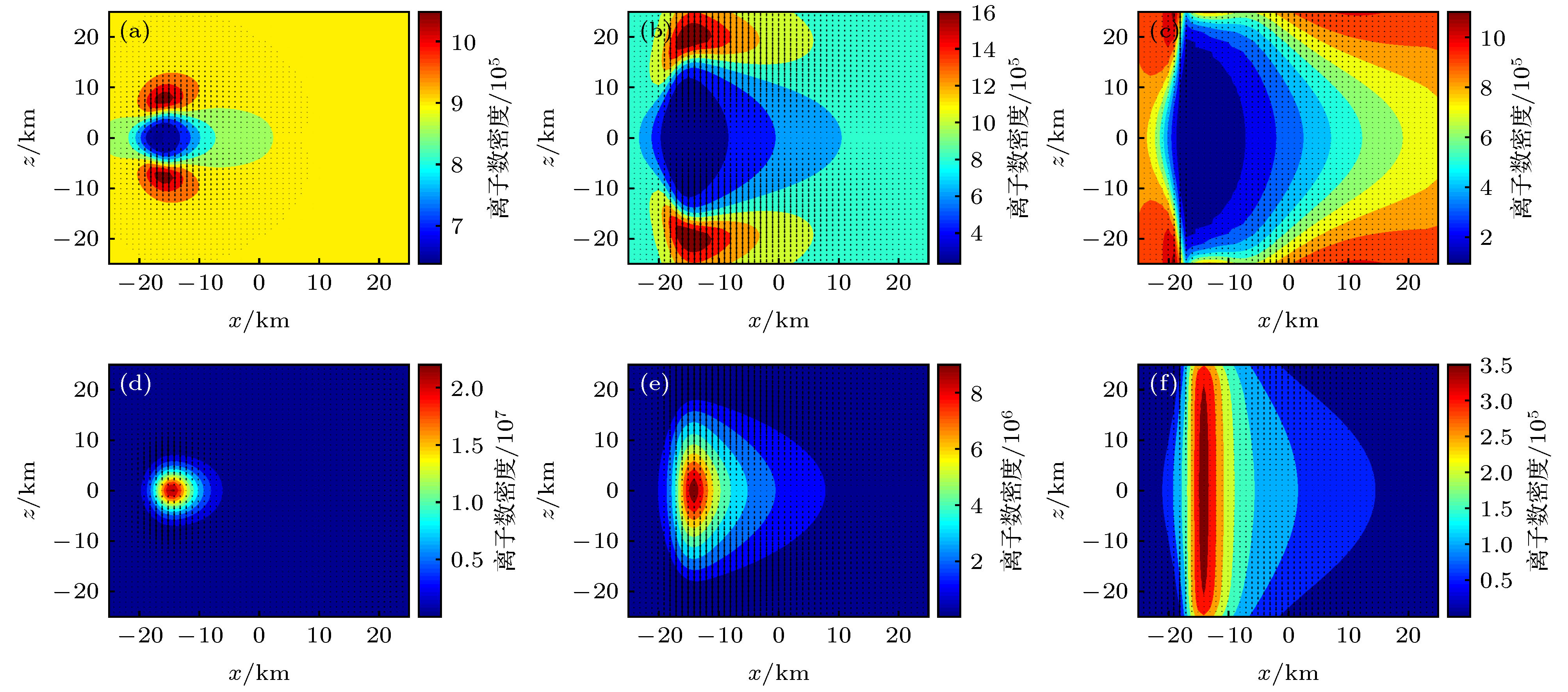-
碱金属或碱土金属在电离层释放后, 迅速在太阳辐射作用下发生光电离, 产生正离子和电子, 形成人工等离子体云团. 本文基于三维双成分流体模型, 考虑释放区域水平风场的影响, 探讨了钡和铯在电离层释放后的时空演化规律, 并对钡和铯的电离层扰动效应进行了对比. 模拟结果表明, 不考虑中性风场时, 生成的等离子体云团逐渐沿磁场被拉伸成椭球形结构, 同时, 膨胀的等离子体云会推开背景氧离子, 在释放中心形成氧离子密度空洞, 并在两侧产生两个对称的密度尖峰; 水平风场的存在会使得生成的离子云逆风侧的密度梯度变陡, 释放物质对背景氧离子的扰动也更大; 对比钡与铯的释放结果发现, 由于铯的扩散系数较小, 钡云的膨胀更为迅速, Ba+云团的覆盖区域更广; 而由于光电离率较大, 释放相同质量下铯的离子产率更高; 此外, Cs+的扫雪机效应比Ba+扫雪机更强, 氧离子密度空穴和凸起处的扰动也更大.After being released in the ionosphere, alkali-metal atoms will be rapidly photoionized by solar UV, producing positive ions and electrons, and forming artificial plasma cloud. Based on a three-dimensional two-species fluid model, considering both the loss of barium atoms due to photoionization and oxidation and the influence of horizontal wind field in the release region, the spatial-temporal evolution of the artificial plasma cloud is discussed. By taking into account the electromagnetic field force, pressure gradient, particle collisions and ion inertia, the ionospheric disturbance effects caused by barium and cesium are compared with each other. The simulation results show that the alkali metal rapidly expands after being released in the ionosphere, and the generated plasma cloud gradually forms an ellipsoidal structure from the inside to the outside under the constraint of magnetic field with considering no wind. Meanwhile, the expanded plasma cloud pushes away the background oxygen ions, forming an oxygen ion density hole in the release center and two symmetrical density bumps on both sides. In the absence of neutral wind, the plasma cloud is dominated by the movement along magnetic field, while considering the background neutral wind, the plasma cloud and background disturbance area will move along the direction of wind, so that the density gradient of plasma cloud becomes steepening on the upwind side. Although the movement of ion cloud across the magnetic field is constrained, the neutrals can pass through the magnetic field freely, so the ion cloud and neutral cloud will separate from each other slowly. Also, the presence of horizontal wind field will make a greater disturbance to the background oxygen ion. By comparing the simulation results of barium and cesium we can see that, qualitatively, the expansion characteristics of Cs+ and Ba+ as well as their effects on the background O+ are similar. Due to the small diffusion coefficient of cesium, the barium cloud expands more rapidly and the coverage area of Ba+ cloud is wider. Because of the large photoionization rate of cesium, the ionization yield of cesium is higher than that of barium when the same mass is released. In addition, the snowplow effect of Cs+ is stronger than that of Ba+, and the oxygen ion density holes and bumps caused by Cs+ are also larger.
-
Keywords:
- artificial plasma clouds /
- neutral diffusion model /
- three-dimensional two-species model /
- snowplow effect
[1] Foppl H, Haerendel G, Haser L, Lutjens P, Lust R, Melzner F, Meyer B, Neuss H, Rieger E 1967 Planet. Space Sci. 15 357
 Google Scholar
Google Scholar
[2] Haerendel G, Foppl H, Melzner F, Neuss H, Rieger E, Stocker J, Bauer O, Hofner H, Loidl J 1986 Nature 320 700
 Google Scholar
Google Scholar
[3] Caton R G, Pedersen T R, Groves K M, et al. 2017 Radio Sci. 52 539
 Google Scholar
Google Scholar
[4] Huba J D, Bernhardt P A, Lyon J G 1992 J. Geophys. Res. Space Phys. 97 11
 Google Scholar
Google Scholar
[5] Lloyd K H, Haerendel G 1973 J. Geophys. Res. 78 7389
 Google Scholar
Google Scholar
[6] Morse D L, Destler W W 1973 J. Geophys. Res. 78 7417
 Google Scholar
Google Scholar
[7] Bernhardt P A, Roussel-Dupre R A, Pongratz M B, et al. 1987 J. Geophys. Res. 92 5777
 Google Scholar
Google Scholar
[8] Zakharov Y P 2002 Adv. Space Res. 29 1335
 Google Scholar
Google Scholar
[9] Haerendel G, Lust R, Rieger E 1967 Planet. Space Sci. 15 1
 Google Scholar
Google Scholar
[10] Schunk R W, Szuszczewicz E P 1988 J. Geophys. Res. Space Phys. 93 12901
 Google Scholar
Google Scholar
[11] Mitchell H G, Fedder J A, Huba J D, Zalesak S T 1985 J. Geophys. Res. Space Phys. 90 11091
 Google Scholar
Google Scholar
[12] Rozhansky V A, Veselova I Y, Voskoboynikov S P 1990 Planet. Space Sci. 38 1375
 Google Scholar
Google Scholar
[13] Drake J F, Mulbrandon M, Huba J D 1988 Phys. Fluids 31 3412
 Google Scholar
Google Scholar
[14] Ma T Z, Schunk R W 1991 J. Geophys. Res. Space Phys. 96 5793
 Google Scholar
Google Scholar
[15] Ma T Z, Schunk R W 1994 J. Geophys. Res. 99 6331
 Google Scholar
Google Scholar
[16] Mendillo M, Hawkins G S, Klobuchar J A 1975 Science 18734 3
[17] Klobuchar J A, Abdu M A 1989 J. Geophys. Res. Space Phys. 94 2721
 Google Scholar
Google Scholar
[18] Choueiri E Y, Oraevsky V N, Dokukin V S 2001 J. Geophys. Res. 106 25673
 Google Scholar
Google Scholar
[19] Bernhardt P A 1979 J. Geophys. Res. 84 793
 Google Scholar
Google Scholar
[20] Mendillo M, Semeter J, Noto J 1993 Adv. Space Res. 13 55
[21] Scales W A, Bernhardt P A, Ganguli G 1994 J. Geophys. Res. 99 373
 Google Scholar
Google Scholar
[22] Kolomiitsev O P, Ruzhin Y Y, Egorov I B, Razinkov O G, Cherkashin Y N 1999 Phys. Chem. Earth Part C 24 393
 Google Scholar
Google Scholar
[23] 黄文耿, 古士芬 2005 空间科学学报 25 254
 Google Scholar
Google Scholar
Huang W G, Gu S F 2005 Chin. J. Space Sci. 25 254
 Google Scholar
Google Scholar
[24] 黄勇, 时家明, 袁忠才 2011 地球物理学报 54 1
 Google Scholar
Google Scholar
Huang Y, Shi J M, Yuan Z C 2011 Chin J. Geophys. 54 1
 Google Scholar
Google Scholar
[25] 胡耀垓, 赵正予, 张援农 2010 物理学报 59 8293
 Google Scholar
Google Scholar
Hu Y G, Zhao Z Y, Zhang Y N 2010 Acta Phys. Sin. 59 8293
 Google Scholar
Google Scholar
[26] 胡耀垓, 赵正予, 张援农 2013 物理学报 62 209401
 Google Scholar
Google Scholar
Hu Y G, Zhao Z Y, Zhang Y N 2013 Acta Phys. Sin. 62 209401
 Google Scholar
Google Scholar
[27] 汪四成, 方涵先, 杨升高, 翁利斌 2012 地球物理学研究进展 27 2464
Wang S C, Fang H X, Yang S G 2012 Progress in Geophys. 27 2464
[28] 赵海生, 许正文, 吴振森, 冯杰, 吴健, 徐彬, 徐彤, 胡艳莉 2016 物理学报 65 209401
 Google Scholar
Google Scholar
Zhao H S, Xu Z W, Wu Z S, Feng J, Wu J, Xu B, Xu T, Hu Y L 2016 Acta Phys. Sin. 65 209401
 Google Scholar
Google Scholar
[29] Li L, Xu R L 2002 Chin. Phys. Lett. 19 1214
 Google Scholar
Google Scholar
[30] 胡耀垓, 赵正予, 张援农 2012 物理学报 61 089401
 Google Scholar
Google Scholar
Hu Y G, Zhao Z Y, Zhang Y N 2012 Acta Phys. Sin. 61 089401
 Google Scholar
Google Scholar
[31] 谢良海 2013 博士学位论文(北京: 中国科学院大学)
Xie L H 2013 Ph. D. Dissertation (Beijing: University of Chinese Academy of Sciences) (in Chinese)
[32] Scholer, M 1970 Planet. Space Sci. 18 977
 Google Scholar
Google Scholar
[33] Pressman J, Marrmo F F, Aschenbrand L M 1960 Planet. Space Sci. 2 228
 Google Scholar
Google Scholar
[34] Holmgren G, Kintner P M, Kelley M C 1981 Adv. Space Res. 1 311
 Google Scholar
Google Scholar
[35] Eliason L, Lundin R, Holmgren G 1988 Adv. Space Res. 8 93
[36] Bleecker D K, Bogaerts A, Gijbels R, Goedheer W 2004 Phys. Rev. E 69 056409
 Google Scholar
Google Scholar
[37] Xing Z, Anbang S, Le T, Guan J Z 2019 AIP Adv. 9 015117
 Google Scholar
Google Scholar
-
图 2 无中性风场时, 300 km高度释放10 kg钡后钡离子和氧离子的离子数密度分布(x-y平面) (a) Ba+, t = 5 s; (b) Ba+, t = 30 s; (c) Ba+, t = 200 s; (d) O+, t = 5 s; (e) O+, t = 30 s; (f) O+, t = 200 s
Fig. 2. Density distribution of Ba+ and O+ (in x-y plane) after 10 kg barium released at 300 km while no neutral wind is considered: (a) Ba+, t = 5 s; (b) Ba+, t = 30 s; (c) Ba+, t = 200 s; (d) O+, t = 5 s; (e) O+, t = 30 s; (f) O+, t = 200 s.
图 3 无中性风场时, 300 km高度释放10 kg钡后钡离子和氧离子的粒子数密度分布(x-z平面) (a) O+, t = 5 s; (b) O+, t = 30 s; (c) O+, t = 200 s; (d) Ba+, t = 5 s; (e) Ba+, t = 30 s; (f) Ba+, t = 200 s
Fig. 3. Density distribution of Ba+ and O+ (in x-z plane) after 10 kg barium released at 300 km while no neutral wind is considered: (a) O+, t = 5 s; (b) O+, t = 30 s; (c) O+, t = 200 s; (d) Ba+, t = 5 s; (e) Ba+, t = 30 s; (f) Ba+, t = 200 s.
图 4 存在x方向大小为1 km/s的中性风时, 300 km高度释放10 kg钡后钡离子和氧离子的粒子数密度分布(x-z平面) (a) O+, t = 5 s; (b) O+, t = 30 s; (c) O+, t = 200 s; (d) Ba+, t = 5 s; (e) Ba+, t = 30 s; (f) Ba+, t = 200 s
Fig. 4. Density distribution of Ba+ and O+ (in x-z plane) after 10 kg barium released at 300 km with a neutral wind of 1 km/s in the x direction: (a) O+, t = 5 s;(b) O+, t = 30 s; (c) O+, t = 200 s; (d) Ba+, t = 5 s; (e) Ba+, t = 30 s; (f) Ba+, t = 200 s.
图 6 存在x方向大小为1 km/s的中性风时, 300 km高度释放10 kg铯的粒子数密度分布(x-z平面) (a) O+, t = 5 s; (b) O+, t = 30 s; (c) O+, t = 200 s; (d) Cs+, t = 5 s; (e) Cs+, t = 30 s; (f) Cs+, t = 200 s
Fig. 6. Density distribution of Cs+ and O+ (in x-z plane) after 10 kg cesium released at 300 km with a neutral wind of 1 km/s in the x direction: (a) O+, t = 5 s; (b) O+, t = 30 s; (c) O+, t = 200 s; (d) Cs+, t = 5 s; (e) Cs+, t = 30 s; (f) Cs+, t = 200 s.
表 1 主要仿真参数表
Table 1. The main simulation parameters.
-
[1] Foppl H, Haerendel G, Haser L, Lutjens P, Lust R, Melzner F, Meyer B, Neuss H, Rieger E 1967 Planet. Space Sci. 15 357
 Google Scholar
Google Scholar
[2] Haerendel G, Foppl H, Melzner F, Neuss H, Rieger E, Stocker J, Bauer O, Hofner H, Loidl J 1986 Nature 320 700
 Google Scholar
Google Scholar
[3] Caton R G, Pedersen T R, Groves K M, et al. 2017 Radio Sci. 52 539
 Google Scholar
Google Scholar
[4] Huba J D, Bernhardt P A, Lyon J G 1992 J. Geophys. Res. Space Phys. 97 11
 Google Scholar
Google Scholar
[5] Lloyd K H, Haerendel G 1973 J. Geophys. Res. 78 7389
 Google Scholar
Google Scholar
[6] Morse D L, Destler W W 1973 J. Geophys. Res. 78 7417
 Google Scholar
Google Scholar
[7] Bernhardt P A, Roussel-Dupre R A, Pongratz M B, et al. 1987 J. Geophys. Res. 92 5777
 Google Scholar
Google Scholar
[8] Zakharov Y P 2002 Adv. Space Res. 29 1335
 Google Scholar
Google Scholar
[9] Haerendel G, Lust R, Rieger E 1967 Planet. Space Sci. 15 1
 Google Scholar
Google Scholar
[10] Schunk R W, Szuszczewicz E P 1988 J. Geophys. Res. Space Phys. 93 12901
 Google Scholar
Google Scholar
[11] Mitchell H G, Fedder J A, Huba J D, Zalesak S T 1985 J. Geophys. Res. Space Phys. 90 11091
 Google Scholar
Google Scholar
[12] Rozhansky V A, Veselova I Y, Voskoboynikov S P 1990 Planet. Space Sci. 38 1375
 Google Scholar
Google Scholar
[13] Drake J F, Mulbrandon M, Huba J D 1988 Phys. Fluids 31 3412
 Google Scholar
Google Scholar
[14] Ma T Z, Schunk R W 1991 J. Geophys. Res. Space Phys. 96 5793
 Google Scholar
Google Scholar
[15] Ma T Z, Schunk R W 1994 J. Geophys. Res. 99 6331
 Google Scholar
Google Scholar
[16] Mendillo M, Hawkins G S, Klobuchar J A 1975 Science 18734 3
[17] Klobuchar J A, Abdu M A 1989 J. Geophys. Res. Space Phys. 94 2721
 Google Scholar
Google Scholar
[18] Choueiri E Y, Oraevsky V N, Dokukin V S 2001 J. Geophys. Res. 106 25673
 Google Scholar
Google Scholar
[19] Bernhardt P A 1979 J. Geophys. Res. 84 793
 Google Scholar
Google Scholar
[20] Mendillo M, Semeter J, Noto J 1993 Adv. Space Res. 13 55
[21] Scales W A, Bernhardt P A, Ganguli G 1994 J. Geophys. Res. 99 373
 Google Scholar
Google Scholar
[22] Kolomiitsev O P, Ruzhin Y Y, Egorov I B, Razinkov O G, Cherkashin Y N 1999 Phys. Chem. Earth Part C 24 393
 Google Scholar
Google Scholar
[23] 黄文耿, 古士芬 2005 空间科学学报 25 254
 Google Scholar
Google Scholar
Huang W G, Gu S F 2005 Chin. J. Space Sci. 25 254
 Google Scholar
Google Scholar
[24] 黄勇, 时家明, 袁忠才 2011 地球物理学报 54 1
 Google Scholar
Google Scholar
Huang Y, Shi J M, Yuan Z C 2011 Chin J. Geophys. 54 1
 Google Scholar
Google Scholar
[25] 胡耀垓, 赵正予, 张援农 2010 物理学报 59 8293
 Google Scholar
Google Scholar
Hu Y G, Zhao Z Y, Zhang Y N 2010 Acta Phys. Sin. 59 8293
 Google Scholar
Google Scholar
[26] 胡耀垓, 赵正予, 张援农 2013 物理学报 62 209401
 Google Scholar
Google Scholar
Hu Y G, Zhao Z Y, Zhang Y N 2013 Acta Phys. Sin. 62 209401
 Google Scholar
Google Scholar
[27] 汪四成, 方涵先, 杨升高, 翁利斌 2012 地球物理学研究进展 27 2464
Wang S C, Fang H X, Yang S G 2012 Progress in Geophys. 27 2464
[28] 赵海生, 许正文, 吴振森, 冯杰, 吴健, 徐彬, 徐彤, 胡艳莉 2016 物理学报 65 209401
 Google Scholar
Google Scholar
Zhao H S, Xu Z W, Wu Z S, Feng J, Wu J, Xu B, Xu T, Hu Y L 2016 Acta Phys. Sin. 65 209401
 Google Scholar
Google Scholar
[29] Li L, Xu R L 2002 Chin. Phys. Lett. 19 1214
 Google Scholar
Google Scholar
[30] 胡耀垓, 赵正予, 张援农 2012 物理学报 61 089401
 Google Scholar
Google Scholar
Hu Y G, Zhao Z Y, Zhang Y N 2012 Acta Phys. Sin. 61 089401
 Google Scholar
Google Scholar
[31] 谢良海 2013 博士学位论文(北京: 中国科学院大学)
Xie L H 2013 Ph. D. Dissertation (Beijing: University of Chinese Academy of Sciences) (in Chinese)
[32] Scholer, M 1970 Planet. Space Sci. 18 977
 Google Scholar
Google Scholar
[33] Pressman J, Marrmo F F, Aschenbrand L M 1960 Planet. Space Sci. 2 228
 Google Scholar
Google Scholar
[34] Holmgren G, Kintner P M, Kelley M C 1981 Adv. Space Res. 1 311
 Google Scholar
Google Scholar
[35] Eliason L, Lundin R, Holmgren G 1988 Adv. Space Res. 8 93
[36] Bleecker D K, Bogaerts A, Gijbels R, Goedheer W 2004 Phys. Rev. E 69 056409
 Google Scholar
Google Scholar
[37] Xing Z, Anbang S, Le T, Guan J Z 2019 AIP Adv. 9 015117
 Google Scholar
Google Scholar
计量
- 文章访问数: 13987
- PDF下载量: 91
- 被引次数: 0













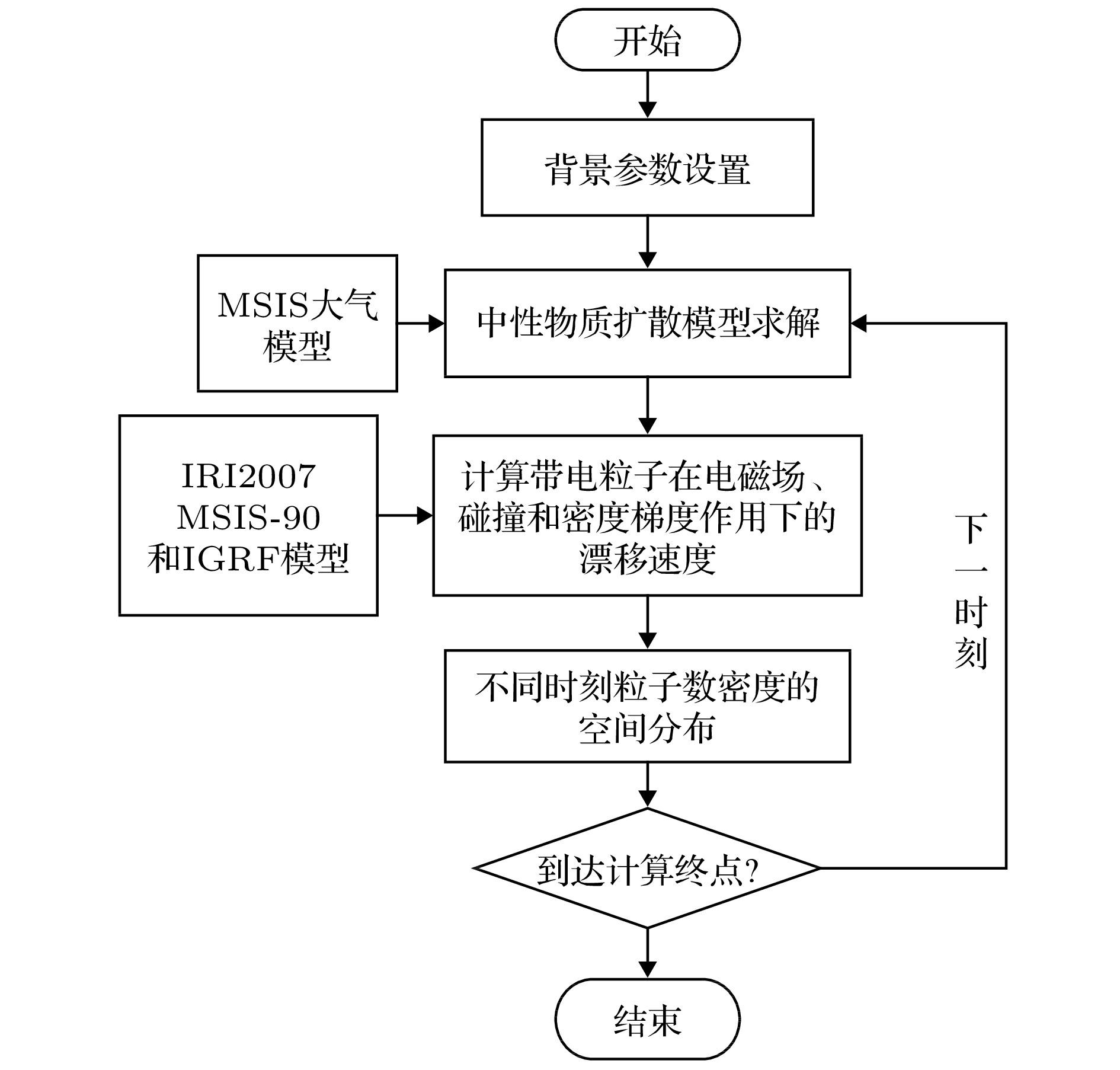
 下载:
下载:
